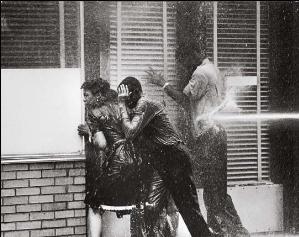Our website is made possible by displaying online advertisements to our visitors.
Please consider supporting us by disabling your ad blocker.
Birmingham campaign
| Birmingham campaign | |||
|---|---|---|---|
| Part of the Civil Rights Movement | |||
 High school students are hit by a high-pressure water jet from a fire hose during a peaceful walk in Birmingham, Alabama in 1963. As photographed by Charles Moore, images like this one, printed in Life, galvanized global support for the demonstrators.[1][2] | |||
| Date | April 3 – May 10, 1963[3] | ||
| Location | |||
| Resulted in |
| ||
| Parties | |||
| |||
| Lead figures | |||
| |||
The Birmingham campaign, also known as the Birmingham movement or Birmingham confrontation, was an American movement organized in early 1963 by the Southern Christian Leadership Conference (SCLC) to bring attention to the integration efforts of African Americans in Birmingham, Alabama.
Led by Martin Luther King Jr., James Bevel, Fred Shuttlesworth and others, the campaign of nonviolent direct action culminated in widely publicized confrontations between young black students and white civic authorities, and eventually led the municipal government to change the city's discrimination laws.
In the early 1960s, Birmingham was one of the most racially divided cities in the United States, enforced both legally and culturally. Black citizens faced legal and economic disparities, and violent retribution when they attempted to draw attention to their problems. Martin Luther King Jr. called it the most segregated city in the country.[4] Protests in Birmingham began with a boycott led by Shuttlesworth meant to pressure business leaders to open employment to people of all races, and end segregation in public facilities, restaurants, schools, and stores. When local business and governmental leaders resisted the boycott, the SCLC agreed to assist. Organizer Wyatt Tee Walker joined Birmingham activist Shuttlesworth and began what they called Project C, a series of sit-ins and marches intended to provoke mass arrests.[5]
When the campaign ran low on adult volunteers, James Bevel thought of the idea of having students become the main demonstrators in the Birmingham campaign.[6] He then trained and directed high school, college, and elementary school students in nonviolence, and asked them to participate in the demonstrations by taking a peaceful walk 50 at a time from the 16th Street Baptist Church to City Hall in order to talk to the mayor about segregation. This resulted in over a thousand arrests, and, as the jails and holding areas filled with arrested students, the Birmingham Police Department, at the direction of the city Commissioner of Public Safety, Eugene "Bull" Connor, used high-pressure water hoses and police attack dogs on the children and adult bystanders.[7] Not all of the bystanders were peaceful, despite the avowed intentions of SCLC to hold a completely nonviolent walk, but the students held to the nonviolent premise. Martin Luther King Jr. and the SCLC drew both criticism and praise for allowing children to participate and put themselves in harm's way.
The Birmingham campaign was a model of nonviolent direct action protest and, through the media, drew the world's attention to racial segregation in the South. It burnished King's reputation, ousted Connor from his job, forced desegregation in Birmingham, and directly paved the way for the Civil Rights Act of 1964 which prohibited racial discrimination in hiring practices and public services throughout the United States.
- ^ "Birmingham 1963". 100 Photographs That in the Digital Journalist. Retrieved December 23, 2007.
- ^ Life magazine May 17, 1963, p. 26, at Google Books – Moore's Birmingham photographs
- ^ Lowery, Charles D.; Marszalek, John F.; Thomas Adams Upchurch, eds. (2003). "Birmingham Confrontation". The Greenwood Encyclopedia of African American Civil Rights: From Emancipation to the Twenty-First Century. Vol. 1 (Second ed.). Greenwood Press. p. 47. ISBN 978-0-313-32171-9.
- ^ Undated interview with King, included in Spike Lee's documentary 4 Little Girls.
- ^ Eyes on the Prize; Interview with Wyatt Tee Walker, retrieved February 11, 2021
- ^ Eyes on the Prize; Interview with James Bevel, retrieved February 11, 2021
- ^ "Children have changed America before, braving fire hoses and police dogs for civil rights". The Washington Post. March 23, 2018.
Previous Page Next Page


